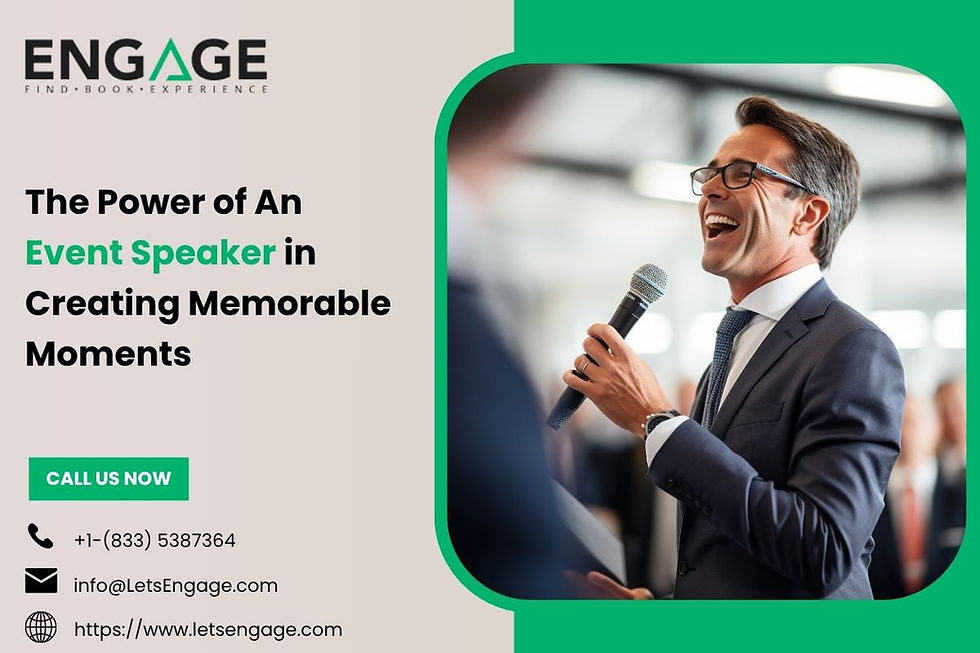The Power of An Event Speaker in Creating Memorable Moments
- steffanmartin233
- Oct 9
- 4 min read
An event speaker is not just a filler of the time slot; a professional event speaker alters the energy in the room, establishes the mood, and leaves a mark on the audience that they take home. Stories told to the audience that resonate with them are remembered, not the slide decks that talk at them, and the correct voice can make a common agenda a common experience.

Why the choice of speaker influences the entire experience
The choice of the appropriate speaker begins with clear objectives and a precise understanding of your attendees. By setting goals, knowing what to expect, and making your logistics plan well in advance, you accomplish a great deal of speaker fit and results out of the room. Viewers watch longer when they see content that is made to suit them and presented by a person who has a style best suited to the occasion, not a big name. That congruency works in your favor, as feeling the talent lends some degree of credibility to your message and reinterprets old concepts in a fashion that people do recall.
Moving the number of sales moments
In the case of revenue teams, sales speakers would be able to turn a kickoff or summit into a playbook instead of a pep talk. The best sales voices are those that tailor stories and strategies to your market reality, strengthen your approach to doing things, and train managers to coach what they just listened to, making inspirations become executions after the fact. It is the reason these speakers get contracted in sales kickoffs, retreats, and conferences at a regular rate, as they motivate team members and provide them with field-tested strategies they can implement on Monday.
When you have both experienced and novice close people in your audience, you can use a format that encourages engagement: live objection-handling, role-play breakouts, or high-speed Q&A. Participation-oriented formats will capture their attention, retain it better, and produce a perception of value, particularly with the assistance of quick polls and moderated discussion.
The secret will never forget that talk
Stories are recalled more than facts. Narrative keynotes use multiple areas of the brain and cause feelings to be encoded so that they can be stored in long-term memory, and hence, the result is that audiences recall stories much easier than facts without the narrative. Structured Q&A shift, word clouds, and engagement tools, live polls transform passive participants into active participants and enhance their memory, and make a keynote two-way.
The event statistics on a bigger scale lead in the same direction: visitors prefer formats where they can learn by doing, where they can engage directly with experts, and where they can feel they have a unique experience in their own words. And that is precisely the landscape in which an adept event speaker flourishes.
Make it local
In case you are planning for the U.S. audience, take into consideration geography. In New York, you need to be fast-paced and pointed in your interaction; in Austin, LA, Chicago, or Atlanta, things are likely to require a new pace and cultural touch. Create a local reference base and give space to local Q&A to get the speaker telling the story to land in that room that you have. (then make it scalable with teams from other states capturing clips) The hybrid reality is also significant: according to planners, mixing face-to-face time with virtual access increases the size of the audience and post-event interaction when done purposefully.
An effective guideline to get the right voice on board
1) Clarify success: Delimit the single outcome you need to accomplish: behavior change among sellers, alignment on a new strategy, or a culture change, based on inclusion. That objective will determine the profile and format of the speaker.
2) Map your audience: Segment based on role, tenure, region, and comfort with interactivity. Customizing the messages to these groups increases engagement and retention.
3) Choose the story and action: Prefer orators who combine storytelling with participatory design, live diagnostics, brief exercises, or guided questions, and answer, since group action is better than sitting and listening.
4) Find a balance between inspiration and tools: In the case of sales speakers, request take-home structures (call plans, discovery maps, follow-up cadences). To diversity speakers, request common habits that can be embraced by managers daily.
5) Rehearse the handoff: Make arrangements with the inside leaders to have the keynote flow into workshops, breakouts, or manager huddles, the moment to movement. According to attendees, practical and expert-led activities have the greatest value.
6) Memory design: You want your speaker to start with a graphic narrative, go back to it in the middle of the speech, and bring your speech full-circle with a call to action. That narrative structure enhances memory over lectures where the only thing presented is facts.
7) Measure what matters: Do not use vanity scores alone; use in-room sentiment and post-event survey and follow-up behavior measurements (pipeline hygiene, manager 1:1s, ERG participation). Hybrid programs also enable you to monitor replay view and content completion following the event.
Bottom line
An accidental moment is hardly something to remember. It is the work of a speaker who can read a room, tell the story that could be remembered, and make people become a part of an experience. Find an event speaker that can accomplish all three, and you will notice the change in the buzz in the hallways, the follow-through, and how people will be talking about the day weeks later.




Comments